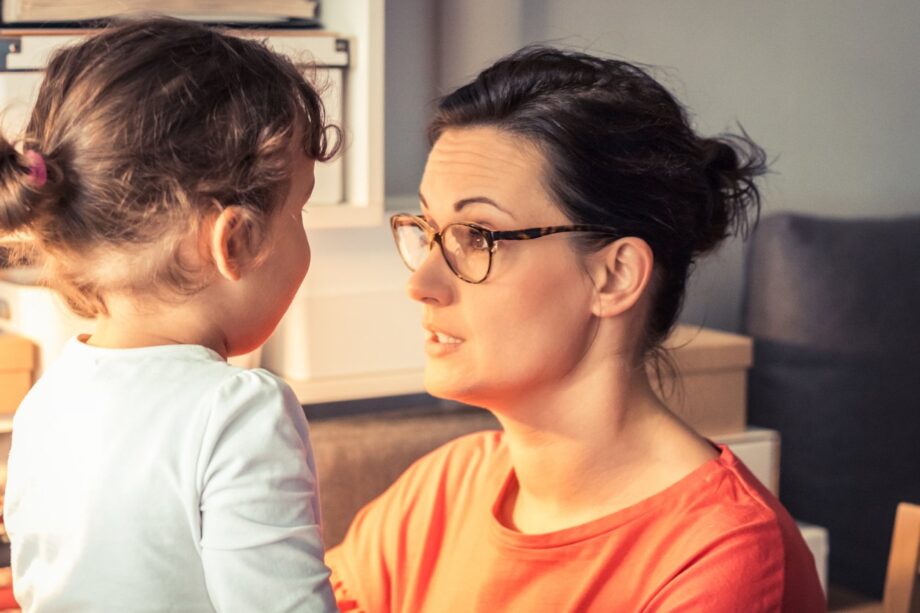How early is too early to teach children about consent and bodily autonomy? You may be surprised to hear that there isn’t such a thing as too young. In fact, Kae Burdo, a sex educator and Advisory Council Member of the Effing Foundation for Sex-Positivity, who has worked to educate children for more than 12 years, says that this education “should start at birth.”

Giving and Obtaining Consent: How to Give Your Kids the Lessons You Probably Never Got
Usually, conversations about teaching consent and bodily autonomy are based in the context of sex, which makes us think that these conversations should be had when a child is old enough to talk about sex. In actuality, education around consent and bodily autonomy doesn’t have to have anything to do with sex because consent and bodily autonomy shouldn’t be limited to the realm of sexual situations. As Burdo puts it, “There’s no need to use the word sex with kids under a certain age; keep the conversation developmentally appropriate. Consent as a concept can be taught well before the word is introduced.”
Read: 15 Reasons Why Parents Don't Talk to Their Kids About Sex
Can you really talk to young kids about consent?
It may seem daunting to teach a young child about consent and bodily autonomy, but it’s easier than you think. Kids give us many natural opportunities throughout the day to discuss these topics; it’s up to us as parents and caregivers to recognize those opportunities and make them into a teaching moment.
I’ve worked with kids on and off for over 15 years, and I’ve worked as a professional caregiver consistently for the last five years. I’ve worked with kids of all ages, from infants to teens. I’ve learned so much about the inherent capacity of children to understand concepts adults assume are complicated. We don’t give kids enough credit when it comes to what they can process, especially if the concept is repeated and modeled on a regular basis. And that’s exactly what I do when I teach kids about consent and bodily autonomy.
What does this look like in practice? Well, the other day the two year old I nanny declared, “I want to pat your booty!” Instead of just saying, “No thank you,” I recognized this as a perfect opportunity to discuss bodily autonomy and consent.
I replied, “Oh. Well, my body is mine, not yours, and I get to make decisions about my own body. I’m saying no, you cannot pat my booty. Since I said no that means you cannot pat my booty. Do you understand?” She smiled and simply replied, “Oh, OK.”
Burdo suggests using similar language, such as, “We don’t touch people’s bodies without asking, we don’t touch people’s bodies if they say no, and we are allowed to say no to people touching our bodies.” The main point, according to Burdo, is to keep the language “accessible.”
Of course, as a two year old, she didn’t absorb the entire concept of giving and respecting consent from that one interaction. So, every time she gives me the opportunity, I repeat the lesson.
What other opportunities do kids provide for us to teach them about consent? One we see all the time is the kid who likes to give hugs or kisses to other kids at playgroup or daycare. Often, we adults think this is super cute, so we just watch the scenario play out. When we do, we miss an important opportunity to talk about bodily autonomy and obtaining consent.
When I’ve seen this situation play out at the daycares I’ve worked at, I always stop the hugger/kisser before they make contact with their target. Then I say, “Can you please ask ___ if they would like a kiss or hug? We should always ask before we touch someone else’s body.” If they ask and the answer is “yes” I watch the adorable interaction happen and melt inside. If the answer is no I’ll tell the hugger/kisser, “___ said no, which means you can’t give them a kiss or hug. ____ gets to make their own decisions about what happens to their body and so do you.”
Again, a single interaction isn’t enough to solidify this concept for any child, but if we use every interaction as an opportunity to teach, the repetition will drive the concept home.
Teaching consent and bodily autonomy doesn’t require a complicated lecture, it just requires recognizing teaching opportunities and capitalizing on them, which kids give us the chance to do every single day.
Read: Why I Decided to Teach My 6-Year-Old About Condoms
How to Model Consent and Bodily Autonomy
Of course, if we want to teach kids about consent and bodily autonomy, then we have to model these things for them, which means we need to be intentional about how we engage with consent and bodily autonomy ourselves. For a lot of parents and caregivers, this is tough. Often, we tell kids they have bodily autonomy and the option to give consent, but then we unintentionally ignore their bodily autonomy and consent. So, how do we address this?
According to Burdo, one of the most important ways we can respect our children’s bodily autonomy and ability to give consent is to make it clear that they don’t have to hug or kiss anyone. As Burdo puts it, “Yes, this includes grandma and mom and dad and anyone.” Burdo continues, “This tends to be very unpopular with grandparents ... but teaching kids that they, and everyone else, get to say no to something as simple and seemingly harmless as a hug is key.”
Often parents feel that to save Grandma’s feelings they should insist that their child give the hug, whether they want to or not. Though our intentions are good, this teaches children that their consent doesn’t matter. Even worse, this teaches them that their discomfort doesn’t matter. If we’re serious about teaching kids to give and respect consent and that they have the power to make their own decisions about their bodies, then a hug or kiss should never be mandatory.
Another time parents and caregivers unintentionally send mixed messages about consent and bodily autonomy is when we don’t listen when a child says “no” or “stop.” We’ve all gotten so caught up in tickling a child that we continue to play even after they ask us to stop. Or we’ve been so intent on getting that hug or kiss or cuddle that we scoop them up and hold them close or cover them in kisses without asking if it’s OK or listening when they say no.
Burdo is adamant that when playing with children adults should stop, “...the moment they say no or stop - even if they’re giggling and seeming to have fun - and letting them know, ‘I heard you say no, which means I am going to stop. Would you like me to continue tickling with you/giving you this airplane ride? Or are we done with playing this way for now?’ This reinforces that ‘nos’ should always be taken seriously, even if they seem playful or uncertain.”
In order to respect the consent and bodily autonomy of the children I work with, I try my best to remember to ask before I scoop them up. If they say no, I forgo the hug that I want. And if we’re cuddling, tickling, or horsing around and a child says “stop,” I stop right away. I usually follow up, as Burdo suggests, with a quick sentence that reinforces their autonomy like, “I heard you say stop and I’m respecting your words,” or “I heard you say no. You always have the option to say no.”
Obviously, the exception is when it’s a matter of safety. Sometimes we have to scoop a little child up to keep them safe or we need to scoop them up when they’re not listening and we’ve exhausted all other options. The way I handle these situations to maintain their bodily autonomy is to offer an explanation of my actions.
If safety is an issue, I’ll say something like, “You’re not being safe so I need to pick you up to keep you safe,” as I’m scooping them up. If listening is the issue, I always give them an opportunity to change their behavior before I intervene by touching them. I’ll say something like, “I’ve given you lots of opportunities to listen and I’ll give you one more. If you can’t listen, I’ll need to come pick you up.”
Another tactic I love when listening is the issue is giving them the option to do it themselves or do it with help. Often when I say, “You have the choice to do this yourself or you have the option of letting me help you.” The child decides to do it on their own, and I got the compliance I was looking for without bodily intervention.
Burdo also stresses the importance of adults modeling consent with each other in front of children. Burdo says, “My partners and I still ask each other for consent regularly, even for hugs.” This teaches their children that the adults they love and respect practice consent and bodily autonomy as well.
In order to truly teach kids that they have control over their bodies, that they can choose to give consent, and that respecting the decisions others make is essential, we have to respect the decisions they make about their own bodies, even if it seems counterintuitive or inconvenient. Modeling consent and bodily autonomy is often more important than the words we use when teaching these concepts.
Why Lessons About Consent Should Start Young
The simple answer is that the earlier kids learn about consent and bodily autonomy the more time they have to practice. The more they hear about consent and bodily autonomy and see these concepts modeled, the more natural it will become for them to put these concepts into practice.
On a more serious note, teaching kids that they are in control of their bodies and that they need to give consent before people touch their bodies gives them the power to deny consent when it’s most important - like when someone wants to touch them inappropriately. It also teaches them to listen to their intuition and honor when they feel uncomfortable, which gives them the knowledge they need in order to know when consent should be denied.
Teaching children about consent and bodily autonomy from a young age also teaches them to respect the bodies of others which, as we all know, is a skill that too many grow up without learning. When little ones are taught to ask for consent from the time they’re toddlers, they’ll know to ask for it when they’re older. If they are taught to respect the bodily autonomy of others, they’ll know that no means no and stop means stop, no exceptions.
If we want our kids to grow up in a world where consent and bodily autonomy are understood and respected, it’s up to us as parents and caregivers to teach them what that means and to model it consistently.
Robin Zabiegalski (they/them) is a queer, non-binary writer, editor, and movement instructor. They've been writing for Kinkly since 2017, and joined Kinkly's Editorial Team in early 2024. Their writing has also been published on xoJane, Heavy.com, Health Digest, Glam, Women.com, The Establishment, Sexual Being, The Tempest, and several other digital media publications. When Robin isn't writing they can be found practicing or teaching yoga, training or teaching Brazilian Jiu Jitsu, playing Fortnite with their partner or chasing their rambunctious kiddo.



